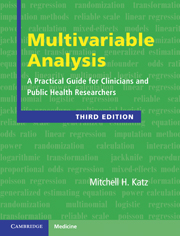Book contents
- Frontmatter
- Contents
- Preface
- 1 Introduction
- 2 Common uses of multivariable models
- 3 Outcome variables in multivariable analysis
- 4 Independent variables in multivariable analysis
- 5 Relationship of independent variables to one another
- 6 Setting up a multivariable analysis
- 7 Performing the analysis
- 8 Interpreting the results
- 9 Delving deeper: Checking the underlying assumptions of the analysis
- 10 Propensity scores
- 11 Correlated observations
- 12 Validation of models
- 13 Special topics
- 14 Publishing your study
- 15 Summary: Steps for constructing a multivariable model
- Index
- References
6 - Setting up a multivariable analysis
Published online by Cambridge University Press: 01 April 2011
- Frontmatter
- Contents
- Preface
- 1 Introduction
- 2 Common uses of multivariable models
- 3 Outcome variables in multivariable analysis
- 4 Independent variables in multivariable analysis
- 5 Relationship of independent variables to one another
- 6 Setting up a multivariable analysis
- 7 Performing the analysis
- 8 Interpreting the results
- 9 Delving deeper: Checking the underlying assumptions of the analysis
- 10 Propensity scores
- 11 Correlated observations
- 12 Validation of models
- 13 Special topics
- 14 Publishing your study
- 15 Summary: Steps for constructing a multivariable model
- Index
- References
Summary
What independent variables should I include in my multivariable model?
On the surface this seems like a simple question. You should include the risk factor(s) of interest and any variables that may potentially confound the relationship between the risk factor and the outcome. However deciding which variables may confound your analysis is not always easy. Variables that are extraneous, redundant, have a lot of missing data, or intervene between your risk factor and outcome should be excluded.
Recommendations on what variables to include and exclude in your model are reviewed in Table 6.1 and discussed in the next two sections.
How do I decide what confounders to include in my model?
Ideally researchers should include all those variables that have been theorized or shown in prior research to be confounders. Depending on the outcome you are studying, there may be a large number of variables that have been shown in prior research to be associated with the risk factor and the outcome. For example, studies of cardiovascular outcomes must include a large number of potential outcomes including age, sex, smoking status, hypertension, diabetes, obesity, LDL-cholesterol, HDL-cholesterol, reactive C-protein, aspirin use, and beta-blocker use because all of these variables have already been shown to affect cardiovascular disease.
TIP
Include in your model those variables that have been theorized or shown in prior research to be confounders of the relationship you are studying.
- Type
- Chapter
- Information
- Multivariable AnalysisA Practical Guide for Clinicians and Public Health Researchers, pp. 93 - 117Publisher: Cambridge University PressPrint publication year: 2011
References
- 8
- Cited by



